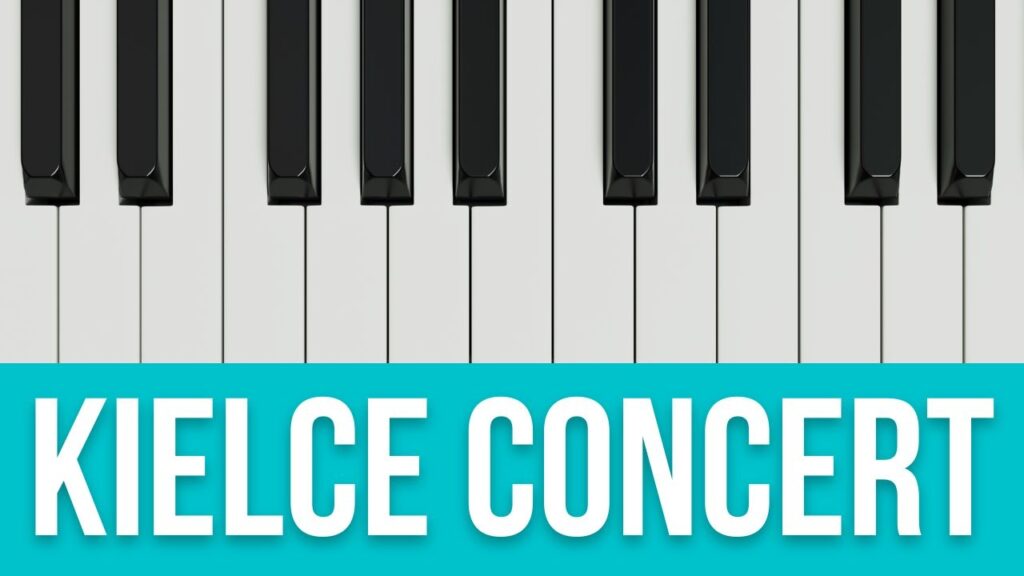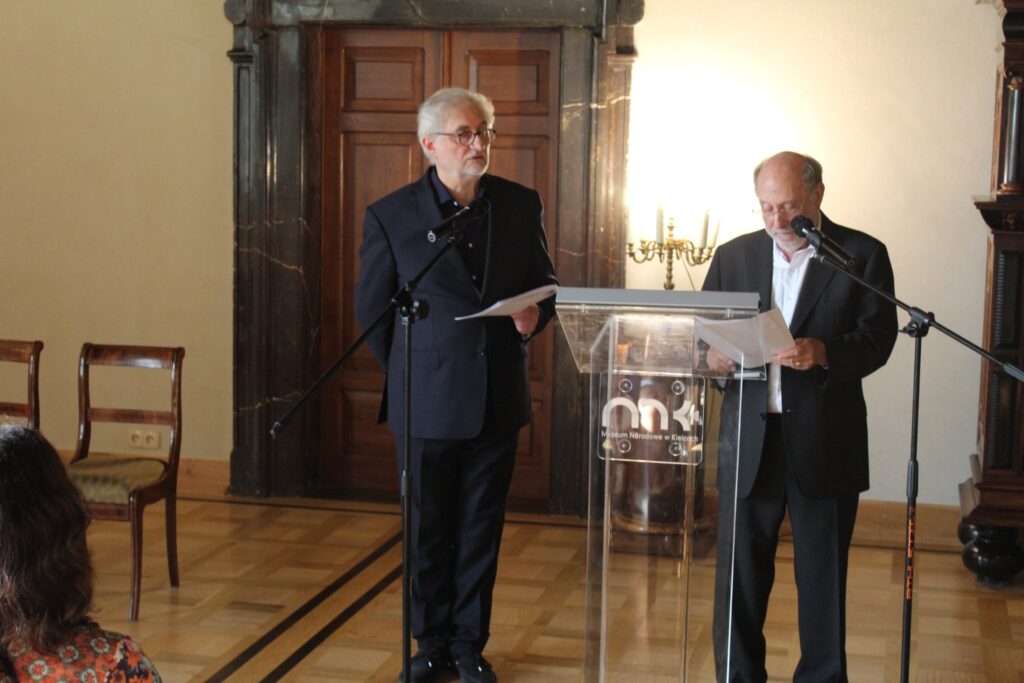FOSTERING A VIBRANT RENEWAL OF JUDAISM IN POLAND

07-04-22 – Good evening. I bring you greetings from my home city Los Angeles, with one of the largest Jewish populations in the world, approx.. 600,000! And I feel honored to share this solemn remembrance of the 1946 Kielce Pogrom with you. Music has always had healing powers and I hope that our program of classical music for violin, cello and piano will have a transformative and comforting effect for us.
I invited three musicians to join me to perform today: Marek Jezowski, violinist, is the president of Beit Polska, the Polish organization which promotes and facilitates progressive Judaism throughout Poland. The cellist, Dominik Płociński, is a serious young professional musician and a prizewinner in the prestigious Lutoslawski and Chopin competitions. Ludmilla Jezowska is a conservatory-trained pianist and is married to Marek Jezowski. I am a classical pianist who became interested in all aspects of Jewish music in the early 1970’s.

Marek Jezowski and Neal Brostoff
Let’s travel back to a rather dark aspect of Jewish religious history in the Middle Ages – After the destruction of the Temple in Jerusalem by the Romans – “Solomon’s Temple – in around the year 70 c.e., the rabbinic authorities forbad most singing and playing of instruments. Exceptions were the chanting of the Torah, the haftarah and other sacred texts, plus chagim (festivals, such as Passover, Shavuot and Sukkot). The joy of weddings could also be amplified by music. But music was otherwise forbidden, with few other exceptions. There was some progress, thanks to the Haskalah – the Jewish enlightenment – in the late 18th-early 19th Centuries. The loosening of restrictions was bundled with other progressive ideas, such as the use of the organ in the synagogue, sermons in German, and mixed choirs. These forward-looking innovations were all helpful to paving the way for Jewish inclusiveness in classical music and there was no turning back!
Many of you may have attended chamber music concerts here in Poland and elsewhere. Chamber music is music for small and medium-sized ensembles, especially string quartets, pioneered by Haydn, Mozart, Beethoven, and the great 19th C. Romantic era composers, including Schubert, Schumann, Mendelssohn and Brahms, and then into the 20th C. But with the dawning of Jewish art music in St. Petersburg in the early 20th C., Jewish chamber music was born and has thrived into the 21st C. You may be interested in knowing about the St. Petersburg connection that I mentioned. During the reign of Catherine the Great, most Jews were only permitted to live in a large landmass known as the Pale of Settlement. This area encompassed parts of present-day Russia, Poland, Belarus, Lithuania and Moldova. In the Pale, Jews did not have access to the educational, social and commercial world that was taken for granted by Russian citizens. And while we know that there was musical activity in the Pale – mostly Yiddish folksongs and klezmer music – the educational restrictions suffered by Jews barred them from musical literacy – the tools for reading and notating music. Therefore, music could only be passed down from one generation to the next by oral transmission. Then, in an unusual historical moment, Czar Alexander II permitted a number of Jews to leave the Pale and enter the world of formal education in large Russian cities, allowing musicians to now access the tools of musical literacy. At the St. Petersburg Conservatory, the famous composer and professor, Nicolai Rimsky-Korsakoff, urged his Jewish music students to study their treasure of Yiddish folksongs and to compose art music – classical music – based on those songs. Rimsky’s students followed his suggestions and, after first only writing formal musical arrangements of Yiddish folksongs, they soon began to expand their experiments with original art songs, chamber music, orchestral and choral music. And so, in 1908, the St. Petersburg Society for Jewish Music was created, perhaps the most important step in the history of Jewish classical music. The society promoted new music composition and performance, competitions, academic studies, with branches in Western Europe and Palestine. We thank the St..Petersburg Society for their pioneering efforts in 20th C. Jewish music.
This evening, you will hear Jewish chamber music (and one unusual piano piece) by Polish and Ukrainian composers. You may ask, “what makes it Jewish”? That is a fair question and not always easy to answer. Is any classical music by Jewish composers automatically Jewish? No. Are there works by non-Jewish composers that have entered the Jewish music canon? Yes – Prokofieff, Shostakovich, Penderecki come to mind. But I still haven’t answered the question. Is the music Jewish if it has a Jewish character, relying on pre-existing Yiddish or Chassidic folk songs and niggunim, klezmer music, sacred liturgical music, etc.? You will need to answer some of these questions for yourself as you listen to the diversity of the repertoire in this evening’s concert.
Many of you are probably familiar with early 20th C. Polish composer Karol Szymanowski. The earlier Maria Szymanowska, Jewish, born in 1789, 21 years before Chopin, was not related to Karol Szymanowski. A native of Warsaw, she emigrated to St. Petersburg, where she grew in stature as one of the first female virtuoso concert pianists and composers. Incidentally, she was the mother-in-law of the 19th C. Polish literary giant Adam Mickiewicz. Szymanowska composed preludes, nocturnes, etudes – sound familiar?! While she and Chopin never met, he acknowledged his familiarity with her compositions and was indebted to many of her stylistic influences. We will present a most unusual and charming nocturne by Szymanowska, for one piano three hands.
While it is obvious that Szymanowska had a profound influence on Chpin’s music, we can see a similar story in Chopin’s influence on the late 19th-early 20th C. L’viv-born composer Paula Szalit. Like Szymanowska, Szalit, who died tragically young at 33, was a dazzling virtuoso concert pianist. Her lyrical solo piano compositions are gentle and comforting. I’ve chosen her Reverie (dreams) for our concert.
A proud son of Lodz, Alexandre Tansman emigrated in the 1930’s to the US and Paris, shuttling between those countries and ultimately living out his life in Paris. He continues to be respected as one of finest 20th C. Polish composers. Tansman , who writes in an accessible Neo-Romantic style, never abandoned his Polish musical roots and the confluence of his Polish-Jewish heritage is evident in his splendid two miniatures for cello and piano. The two pieces – Melodie and Capriccio – also show hints of Tansman’s French side and a cheerful affinity for American and British popular dance music styles. The “Melodie” demonstrates his lyrical side, full of original Jewish motifs, while the lighthearted “Capriccio” is whimsical, free-spirited, and a rhythmic thrill-ride!
From the pioneering early and mid-20th C. composers from the St. Petersburg Society who I told you about a few moments ago, we will hear works by Joseph Achron and Alexander Krein. Achron was a gifted violinist, who was a fellow student with Jascha Heifewtz in the class of Leopold Auer. His Hebrew Melody, a staple of the violin repertoire, is based on a pre-existing Chassidic melody, and it develops from a sweet simple melody to a dramatic and virtuosic tour-de-force for violin, returning again to its humble beginnings at the end.
Alexander Krein was part of large multi-generational family of Russian musicians, not unlike the family of Johann Sebastian Bach. His mastery of Yiddish folk songs, colored by the exotic chromatic writing style of his colleague Alexander Scriabin were the hallmarks of his unique compositional style. His Jewish Melody for cello and piano is one of my personal favorites.
Maurice Ravel was one of the greatest French composers of the 20th C., of mixed Parisian and Basque heritages. He is probably best known for a piece of music that he wished that everyone would forget about – Bolero! (sing or play a bit). Although Ravel was not Jewish, he showed interest in Jewish folk and sacred music sources. The genesis for his meditation on Kaddish, originally composed for voice and harp, uses the “l’yamin nora’im” melody, the one that is chanted on the mornings of Rosh Hashana and Yom Kippur (chant beginning of Kaddish). We will hear Ravel’s Kaddish in the arrangement for violin and piano.
The Swiss-American composer Ernest Bloch is considered by many as the greatest composer of classical Jewish music in the 1st half of the 20th C. His Avodath Hakodesh (“Sacred Service”), continues to be one of the most acclaimed choral works of the 20th C. His cello concerto, “Schelomo” is a favorite of concert cellists worldwide. In his early 20th C. “Jewish cycle” of about 15 years, Bloch composed works that best showed his relation to Judaism – not with familiar folk melodies, but with original music from his heart and neshama (soul). From Bloch’s “Jewish Cycle” we will hear the deeply spiritual Prayer, for cello and piano.
MUSICIANS
- Marek Jezowski, violinist, is the president of Beit Polska, the Polish organization which promotes and facilitates progressive Judaism throughout Poland.
- The cellist, Dominik Płociński, is a serious young professional musician and a prizewinner in the prestigious Lutoslawski and Chopin competitions.
- Ludmilla Jezowska is a conservatory-trained pianist and is married to Marek Jezowski.
- Neal Brostoff is a classical pianist who became interested in all aspects of Jewish music in the early 1970’s.
DONATE TO SUSTAIN OUR FREIGHTED LEGACIES SERIES HERE.
VIEW MORE WEBINARS + SUBSCRIBE TO OUR YOUTUBE CHANNEL.
